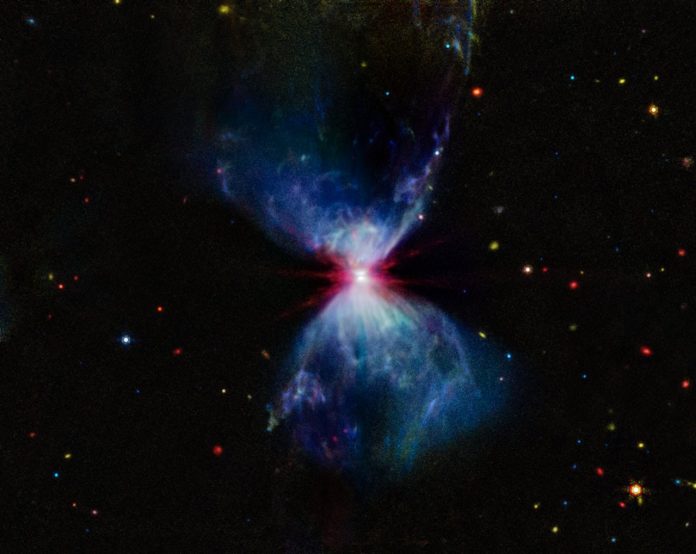
NASA’s James Webb Space Telescope has captured an incredible image that looks like fireworks in space.
This image, taken with Webb’s Mid-Infrared Instrument (MIRI), shows a very young star in the process of forming.
The star, called a protostar, is growing in the middle of a bright hourglass-shaped cloud of gas and dust.
The protostar, which is about 100,000 years old, is still surrounded by the gas and dust from the cloud where it was born.
A previous observation of this region, called L1527, was made with Webb’s Near-Infrared Camera (NIRCam). That image showed the protostar and its surrounding cloud in bright, opaque colors.
Both the NIRCam and MIRI images reveal that the protostar is sending out flows of gas in opposite directions along its rotation axis.
These flows create bow shocks in the surrounding cloud, forming filament-like structures.
These flows also carve out the bright hourglass shape in the cloud, making the regions above and below the protostar glow brightly, similar to fireworks lighting up the night sky.
The MIRI image shows more detail about how these flows interact with the thick dust and gases in the region.
The blue areas in the hourglass shape mostly show carbon-based molecules known as polycyclic aromatic hydrocarbons.
The red areas represent the dense dust and gas surrounding the protostar. The sparkler-like red lines are just artifacts from the telescope’s optics.
A white region is visible directly above and below the protostar in the MIRI image, which is not as clear in the NIRCam view.
This area contains a mixture of hydrocarbons, ionized neon, and thick dust. This shows that the protostar is propelling this matter far away as it consumes material from its disk.
As the protostar continues to grow and release energetic jets, it will eventually consume, destroy, and push away much of the surrounding molecular cloud. Over time, the structures seen in this image will begin to fade.
Eventually, the star will stop gathering mass and become more visible to telescopes that use visible light.
The combination of data from both the near-infrared and mid-infrared views helps scientists understand how the protostar is affecting its surroundings.
Many other stars in the Taurus region, where L1527 is located, are forming in a similar way. This process could either disrupt the formation of new stars or help them develop.



